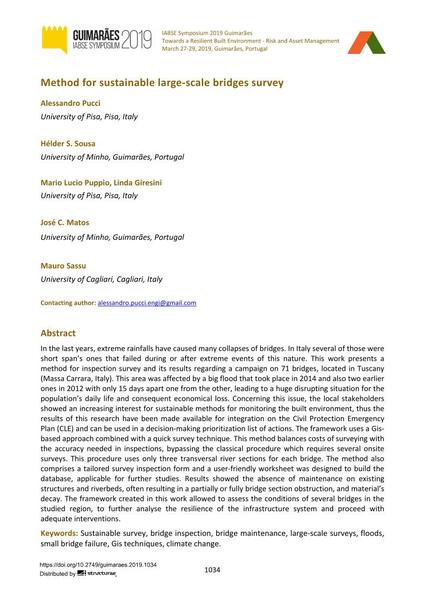Method for sustainable large-scale bridges survey

|
|
|||||||||||
Détails bibliographiques
| Auteur(s): |
Alessandro Pucci
(University of Pisa, Pisa, Italy)
Hélder S. Sousa Mario Lucio Puppio (University of Pisa, Pisa, Italy) Linda Giresini (University of Pisa, Pisa, Italy) José C. Matos Mauro Sassu (University of Cagliari, Cagliari, Italy) |
||||
|---|---|---|---|---|---|
| Médium: | papier de conférence | ||||
| Langue(s): | anglais | ||||
| Conférence: | IABSE Symposium: Towards a Resilient Built Environment Risk and Asset Management, Guimarães, Portugal, 27-29 March 2019 | ||||
| Publié dans: | IABSE Symposium Guimarães 2019 | ||||
|
|||||
| Page(s): | 1034-1041 | ||||
| Nombre total de pages (du PDF): | 8 | ||||
| DOI: | 10.2749/guimaraes.2019.1034 | ||||
| Abstrait: |
In the last years, extreme rainfalls have caused many collapses of bridges. In Italy several of those were short span’s ones that failed during or after extreme events of this nature. This work presents a method for inspection survey and its results regarding a campaign on 71 bridges, located in Tuscany (Massa Carrara, Italy). This area was affected by a big flood that took place in 2014 and also two earlier ones in 2012 with only 15 days apart one from the other, leading to a huge disrupting situation for the population’s daily life and consequent economical loss. Concerning this issue, the local stakeholders showed an increasing interest for sustainable methods for monitoring the built environment, thus the results of this research have been made available for integration on the Civil Protection Emergency Plan (CLE) and can be used in a decision-making prioritization list of actions. The framework uses a Gis- based approach combined with a quick survey technique. This method balances costs of surveying with the accuracy needed in inspections, bypassing the classical procedure which requires several onsite surveys. This procedure uses only three transversal river sections for each bridge. The method also comprises a tailored survey inspection form and a user-friendly worksheet was designed to build the database, applicable for further studies. Results showed the absence of maintenance on existing structures and riverbeds, often resulting in a partially or fully bridge section obstruction, and material’s decay. The framework created in this work allowed to assess the conditions of several bridges in the studied region, to further analyse the resilience of the infrastructure system and proceed with adequate interventions. |
||||
